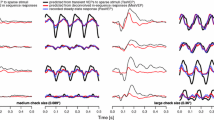Abstract
Contrast sensitivity functions (CSFs) were determined electrophysiologically with the steady-state visual evoked potential (VEP). Psychophysical CSFs obtained by the method of increasing contrasts were also measured concurrently with the VEP trials. The VEP contrast thresholds were obtained using a rapid recording technique in which the contrast of a counterphase sinewave modulated at a temporal frequency of 7.5 Hz was swept from 0.5% to 40% over a period of 22 s in 39 equal logarithmic steps. For this pattern reversal stimulus, the amplitude and phase of the second harmonic response as a function of contrast were measured using a discrete Fourier transform (DFT). Contrast sensitivities at five spatial frequencies ranging from 0.5 to 14.9 cpd were measured. The VEP contrast thresholds were determined by a linear extrapolation to zero amplitude. The contrast threshold obtained by the two methods correlated at 0.816 for 14 subjects. For all five spatial frequencies there were no significant differences between the contrast sensitivities derived from the two methods.
Similar content being viewed by others
References
Sokol S, Domar A, Moskowitz A. Utility of the Arden grating test in glaucoma screening: high false-positive rate in normals over 50 years of age. Invest Ophthalmol Vis Sci 1980; 19: 1529–33.
Hirsch J, Puklin JE. Reduced contrast sensitivity may precede clinically observable retinopathy in Type 1 diabetes. Proceedings of the XXIII International Ophthalmological Congress in San Francisco, California. Philadelphia, Lippincott 1983; 719–724.
Hess RF, Campbell FW, Greenhalgh T. The threshold contrast sensitivity function in strabismic amblyopia: evidence for a two type classification. Vision Res 1977; 17: 1049–55.
Volkers ACW, Hagemans KH et al. Spatial contrast sensitivity and the diagnosis of amblyopia. Br J Ophthalmol 1987; 71: 58–65.
Campbell FW, Maffei L. Electrophysiological evidence for the existence of orientation and size detectors in the human visual system. J Physiol (Lond) 1970; 207: 635–52.
Campbell FW, Kulikowski JJ. The visual evoked potential as a function of contrast of a grating pattern. J Physiol (Lond) 1972; 222: 345–56.
Bodis-Wollner I, Hendley CD, Kulikowski JJ. Electrophysiological and psychophysical responses to modulation of contrast of a grating pattern. Perception 1972; 1341–9.
Murray IJ, Kulikowski JJ. VEPs and contrast. Vision Res 1983; 23: 1741–3.
Fiorentini A, Pirchio M, Spinelli D. Scotopic contrast sensitivity in infants evaluated by evoked potentials. Invest Ophthalmol Vis Sci; 1980; 19: 950–53.
Bobak P, Bodis-Wollner I, Harnois C, Thonton J. VEPs in human reveal high and low spatial contrast mechanisms. Invest Ophthalmol Vis Sci 1984; 25: 980–3.
Nelson JI, Seiple WH, Kupersmith MJ and Carr RE. Lock-in techniques for the swept stimulus evoked potential. J Clin Neurophysiol 1984; 1: 409.
Seiple WH, Kupersmith MJ, Nelson JI, Carr RE. The assessment of evoked potential contrast threshold using real-time retrieval. Invest Ophthalmol Vis Sci 1984; 25: 980–3.
Allen D, Norcia AM, Tyler CW. Comparative study of electrophysiological and psychophysical measurement of the contrast sensitivity function in humans. Am J Optom Physiol Opt 1986; 63: 442–449.
Norcia AM, Tyler CW. Spatial frequency sweep VEP: visual acuity during the first years of life. Vision Res 1985; 25: 1399–1408.
Furuskog P, Wanger P. Visual acuity measurement using evoked potentials and fast Fourier transform. Acta Ophthalmol 1986; 64: 352–355.
Fagan JE, Frederick GE, Yolton RL. Steady-state visual evoked response amplitudes and concurrent electroencephalographic activity. Am J Optom Physiol Opt 1985; 62: 418–422.
Norcia AM, Clarke M, Tyler CW. Digital filtering and robust regression techniques for estimating sensory thresholds from the evoked potential. IEEE Eng Med Biol 1985; 4: 26.
Norcia AM, Tyler CW, Hamer RD. High visual contrast sensitivity in the young human infant. Invest Ophthalmol Vis Sci 1988; 29: 44–49.
Katsumi O, Hirose T, Tsukada T. Effect of number of elements and size of stimulus field on recordability of pattern reversal visual evoked response. Invest Ophthalmol Vis Sci 1988; 29: 922–927.
Author information
Authors and Affiliations
Rights and permissions
About this article
Cite this article
Chen, S., Wu, L. & Wu, D. Objective measurement of contrast sensitivity using the steady-state visual evoked potential. Doc Ophthalmol 75, 145–153 (1990). https://doi.org/10.1007/BF00146550
Accepted:
Issue Date:
DOI: https://doi.org/10.1007/BF00146550




